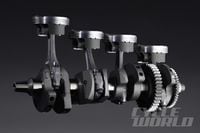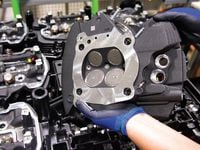Superbike regulations worldwide have adopted stock piston rules, and the new US series, MotoAmerica, has such a rule. Its purpose is to eliminate the advantage top teams had in being able to custom-machine pistons to optimize engine combustion chambers.
The goal of such work is to achieve torque-boosting high compression while creating squish areas, providing working clearance between pistons and valves, and moving air-fuel mixture closer to the single central spark plug. The overall result is faster combustion, leaving less time for its intense heat to flow into surrounding chamber surfaces. The heat saved becomes added pressure to drive the piston, rather than a loss to the cooling system.
Stock engines have not been built this way because of the danger of “tolerance stack-up.” If statistics give a certain cylinder a con-rod that’s a bit long, a cylinder a tiny bit short, and a wristpin a smidge lower than normal in the piston, the piston could hit the head or valves at high revs. We think Yamaha did a study that showed that the expense of controlling these dimensions on the production line was an affordable performance boost.
Whatever is different about the 2015 R1 is working in both Superbike and the close-to-production Superstock classes, which now run together in MotoAmerica events. Superstock Yamahas are finishing high up among the Superbikes. Before the first race, US Superbike champion Josh Hayes said the 2015 stocker was as fast as last year's race engines. That requires something special.

/cloudfront-us-east-1.images.arcpublishing.com/octane/7TO4TMPM6JBJJPBWUMT35TJHHA.jpg)
/cloudfront-us-east-1.images.arcpublishing.com/octane/3CANJMY47BH6BNPDAODAUD3CWQ.jpg)
/cloudfront-us-east-1.images.arcpublishing.com/octane/4IGJJZ6HWNAIHJ343U7CUH4WC4.jpg)
/cloudfront-us-east-1.images.arcpublishing.com/octane/BP5NOY5NPVGOZIDU5FN7M42JMA.jpg)
/cloudfront-us-east-1.images.arcpublishing.com/octane/XH2ETEU4NVGDFNQO2XT2QQS5LU.jpg)
/cloudfront-us-east-1.images.arcpublishing.com/octane/TGJNNI474VFXFMS3YQDRIEKEFY.jpg)
/cloudfront-us-east-1.images.arcpublishing.com/octane/5QAQVX645VA3LKJFZ3C4Y2DTPI.jpg)
/cloudfront-us-east-1.images.arcpublishing.com/octane/45O2MZU525ATPB5GRG422ZTU54.jpg)
/cloudfront-us-east-1.images.arcpublishing.com/octane/WEWXDN2F2BD3DJYUJJX4RZIALA.jpg)
/cloudfront-us-east-1.images.arcpublishing.com/octane/VPDWRXQWRVGULBY7Z3JRGPTR2I.jpg)
/cloudfront-us-east-1.images.arcpublishing.com/octane/56QNDMMUA5EA3OCJINPCI2QZGA.jpg)
/cloudfront-us-east-1.images.arcpublishing.com/octane/BHOJALDF55CPXGFWVLVKBPYZZI.jpg)
/cloudfront-us-east-1.images.arcpublishing.com/octane/BRQMHRCC4FH5HK4D3HUMG6XEKM.jpg)
/cloudfront-us-east-1.images.arcpublishing.com/octane/2CPX3CKQZFFT5H2ISBRTCIAUPY.jpg)
/cloudfront-us-east-1.images.arcpublishing.com/octane/W6JSA4VWCFFDDAAN3AAWO6ZTPE.jpg)
/cloudfront-us-east-1.images.arcpublishing.com/octane/KJ34QPKSPFASHEGWY6FP7Z6C4M.jpg)
/cloudfront-us-east-1.images.arcpublishing.com/octane/3EGYOQSTNVCKZBKYRGZXPWE4XA.jpg)
/cloudfront-us-east-1.images.arcpublishing.com/octane/ZIQ26VLDXJFQBFVPRQ6QL5XFXE.jpg)
/cloudfront-us-east-1.images.arcpublishing.com/octane/RPFWTIVIXBCNRGFI43WNFCABUY.jpg)
/cloudfront-us-east-1.images.arcpublishing.com/octane/R43RXKVKXZAZ3PMB4UKAJRTVBU.jpg)
/cloudfront-us-east-1.images.arcpublishing.com/octane/35RWQS456ZAZFGSE7YVOXOR5YE.jpg)

/cloudfront-us-east-1.images.arcpublishing.com/octane/DCO27D4S45BYNNZTZLWRMCH44M.jpg)
/cloudfront-us-east-1.images.arcpublishing.com/octane/GFK6LFGR7VGNJPH5GXAQRKTGKA.jpg)